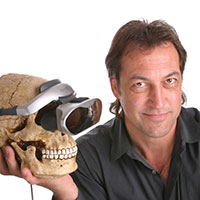Digital and Social Media Affects Society
Social media's growing touch on our lives
Media psychology researchers are start to tease apart the ways in which time spent on social media is, and is not, impacting our day-to-day lives.

Social media employ has skyrocketed over the past decade and a one-half. Whereas only five percent of adults in the United States reported using a social media platform in 2005, that number is now around 70 percent.
Growth in the number of people who use Facebook, Instagram, Twitter, and Snapchat and other social media platforms — and the fourth dimension spent on them—has garnered interest and concern among policymakers, teachers, parents, and clinicians nearly social media's impacts on our lives and psychological well-being.
While the research is still in its early years — Facebook itself only celebrated its fifteenthursday birthday this year — media psychology researchers are beginning to tease apart the ways in which fourth dimension spent on these platforms is, and is not, impacting our twenty-four hour period-to-day lives.
Social media and relationships
One especially pernicious business organisation is whether time spent on social media sites is eating abroad at face-to-face fourth dimension, a miracle known as social displacement .
Fears nigh social deportation are longstanding, equally erstwhile as the phone and probably older. "This outcome of displacement has gone on for more than 100 years," says Jeffrey Hall, PhD, director of the Relationships and Engineering science Lab at the University of Kansas. "No matter what the technology is," says Hall, there is e'er a "cultural belief that it's replacing contiguous fourth dimension with our close friends and family."
Hall's research interrogates that cultural belief. In i study, participants kept a daily log of fourth dimension spent doing nineteen different activities during weeks when they were and were not asked to abjure from using social media. In the weeks when people abstained from social media, they spent more fourth dimension browsing the internet, working, cleaning, and doing household chores. Still, during these same avoidance periods, there was no difference in people's time spent socializing with their strongest social ties.
The upshot? "I tend to believe, given my own work and and so reading the piece of work of others, that at that place's very little show that social media directly displaces meaningful interaction with close relational partners," says Hall. One possible reason for this is because nosotros tend to interact with our close loved ones through several unlike modalities—such as texts, emails, phone calls, and in-person fourth dimension.
What about teens?
When it comes to teens, a contempo written report by Jean Twenge, PhD, professor of psychology at San Diego Country University, and colleagues establish that, every bit a cohort, high school seniors heading to higher in 2016 spent an " hour less a 24-hour interval engaging in in-person social interaction" — such equally going to parties, movies, or riding in cars together — compared with high school seniors in the tardily 1980s. Equally a group, this decline was associated with increased digital media use. Yet, at the individual level, more than social media use was positively associated with more in-person social interaction. The written report also found that adolescents who spent the most time on social media and the least time in face-to-face social interactions reported the most loneliness.
While Twenge and colleagues posit that overall face up-to-confront interactions among teens may be downward due to increased time spent on digital media, Hall says there's a possibility that the relationship goes the other way.
Hall cites the work of danah boyd, PhD, chief researcher at Microsoft Research and the founder of Data & Society. "She [boyd] says that it's non the instance that teens are displacing their social contiguous time through social media. Instead, she argues nosotros got the causality reversed," says Hall. "We are increasingly restricting teens' ability to spend fourth dimension with their peers . . . and they're turning to social media to augment it."
According to Hall, both phenomena could be happening in tandem — restrictive parenting could drive social media use and social media employ could reduce the time teens spend together in person — but focusing on the latter places the culpability more on teens while ignoring the societal forces that are besides at play.
The evidence is articulate about ane affair: Social media is pop amid teens. A 2018 Common Sense Media study found that 81 percent of teens apply social media, and more than than a third written report using social media sites multiple times an 60 minutes. These statistics accept risen dramatically over the by six years, likely driven by increased access to mobile devices. Rising along with these stats is a growing interest in the impact that social media is having on teen cognitive development and psychological well-being.
"What we take found, in general, is that social media presents both risks and opportunities for adolescents," says Kaveri Subrahmanyam, PhD, a developmental psychologist, professor at Cal Land LA, and associate managing director of the Children'southward Digital Media Heart, Los Angeles.
Risks of expanding social networks
Social media benefits teens by expanding their social networks and keeping them in bear upon with their peers and far-away friends and family. It is likewise a inventiveness outlet. In the Common Sense Media report, more than than a quarter of teens said that "social media is 'extremely' or 'very' important for them for expressing themselves creatively."
But there are also risks. The Mutual Sense Media survey institute that xiii per centum of teens reported being cyberbullied at least once. And social media can exist a conduit for accessing inappropriate content like violent images or pornography. Nearly two-thirds of teens who use social media said they "'ofttimes' or 'sometimes' come across racist, sexist, homophobic, or religious-based detest content in social media."
With all of these benefits and risks, how is social media affecting cerebral development? "What nosotros take found at the Children's Digital Media Center is that a lot of digital communication employ and, in particular, social media use seems to be connected to offline developmental concerns," says Subrahmanyam. "If you expect at the boyish developmental literature, the core problems facing youth are sexuality, identity, and intimacy," says Subrahmanyam.
Her enquiry suggests that unlike types of digital advice may involve unlike developmental problems. For example, she has found that teens frequently talked about sex in chat rooms, whereas their use of blogs and social media appears to be more concerned with self-presentation and identity construction.
In particular, exploring one's identity appears to exist a crucial use of visually focused social media sites for adolescents. "Whether it's Facebook, whether it's Instagram, there'southward a lot of strategic self presentation, and information technology does seem to be in the service of identity," says Subrahmanyam. "I think where it gets gray is that we don't know if this is necessarily beneficial or if information technology harms."
Remaining questions
"Information technology's important to develop a coherent identity," she says. "Simply within the context of social media — when it'due south not articulate that people are necessarily engaging in real self presentation and there'due south a lot of ideal-self or false-cocky presentation — is that skillful?"
There are also more questions than answers when it comes to how social media affects the evolution of intimate relationships during adolescence. Does having a wide network of contacts — as is common in social media—lead to more superficial interactions and hinder intimacy? Or, perhaps more important, "Is the support that yous become online as effective equally the support that you get offline?" ponders Subrahmanyam. "We don't know that necessarily."
Based on her own research comparing text messages and face-to-face interactions, she says: "My hypothesis is that perhaps digital interactions may exist a little more ephemeral, they're a lilliputian more fleeting, and you feel good, but that the feeling is lost quickly versus face-to-face interaction."
However, she notes that today's teens — existence tech natives — may go less hung upward on the online/offline dichotomy. " We tend to retrieve about online and offline as disconnected, but we have to recognize that for youth . . . at that place's so much more than fluidity and connectedness between the existent and the physical and the offline and the online," she says.
In fact, growing up with digital technology may be changing teen brain evolution in means nosotros don't yet know — and these changes may, in turn, modify how teens relate to technology. "Because the exposure to technology is happening so early, we have to exist mindful of the possibility that perhaps there are changes happening at a neural level with early on exposure," says Subrahmanyam. "How youths collaborate with technology could just be qualitatively different from how we exercise it."
In part ii of this commodity, nosotros will look at how social media affects psychological well-being and means of using social media that are likely to amplify its benefits and decrease its harms.
Technology, Mind & Social club 2019
APA's Technology, Mind & Lodge conference showcases the most of import electric current inquiry in psychology and other disciplines concerning the interactions of humans and engineering — research that moves us toward the goal of ensuring that engineering enhances the lives of all people.
Technology, Mind & Society Keynote Speakers
 Sara Czaja, PhD is a professor of gerontology and the director of the Eye on Aging and Behavioral Inquiry in the Division of Geriatrics and Palliative Medicine at Weill Cornell Medicine. Czaja's enquiry interests include aging and noesis, aging and healthcare access and service delivery, family caregiving, aging and technology, and functional cess.
Sara Czaja, PhD is a professor of gerontology and the director of the Eye on Aging and Behavioral Inquiry in the Division of Geriatrics and Palliative Medicine at Weill Cornell Medicine. Czaja's enquiry interests include aging and noesis, aging and healthcare access and service delivery, family caregiving, aging and technology, and functional cess.
 Camille Nebeker, EdD, MS is an assistant professor of Behavioral Medicine in the Section of Family unit Medicine & Public Health, School of Medicine at UC San Diego. Nebeker's research focuses on customs research capacity building and the ethical dimensions (e.g., consent, privacy, information direction) of emerging technologies (eastward.grand., pervasive sensors, ubiquitous computing) used in health research.
Camille Nebeker, EdD, MS is an assistant professor of Behavioral Medicine in the Section of Family unit Medicine & Public Health, School of Medicine at UC San Diego. Nebeker's research focuses on customs research capacity building and the ethical dimensions (e.g., consent, privacy, information direction) of emerging technologies (eastward.grand., pervasive sensors, ubiquitous computing) used in health research.
 Albert "Skip" Rizzo, PhD is a clinical psychologist and managing director of Medical VR at the University of Southern California Institute for Artistic Technologies. He is as well a research professor with the USC dept. of psychiatry and schoolhouse of gerontology. Rizzo has conducted enquiry on the pattern, development and evaluation of Virtual Reality (VR) systems targeting the areas of clinical assessment, treatment, and rehabilitation across the domains of psychological, cognitive and motor functioning in both healthy and clinical populations.
Albert "Skip" Rizzo, PhD is a clinical psychologist and managing director of Medical VR at the University of Southern California Institute for Artistic Technologies. He is as well a research professor with the USC dept. of psychiatry and schoolhouse of gerontology. Rizzo has conducted enquiry on the pattern, development and evaluation of Virtual Reality (VR) systems targeting the areas of clinical assessment, treatment, and rehabilitation across the domains of psychological, cognitive and motor functioning in both healthy and clinical populations.
 Valerie Shute, PhD is the Mack & Effie Campbell Tyner Endowed professor in didactics in the department of educational psychology and Learning Systems at Florida State University. Her current research involves using games with stealth assessment to support learning — of cognitive and non-cognitive cognition, skills and dispositions. For more details on her enquiry and publications, read her bio on Florida State University's website.
Valerie Shute, PhD is the Mack & Effie Campbell Tyner Endowed professor in didactics in the department of educational psychology and Learning Systems at Florida State University. Her current research involves using games with stealth assessment to support learning — of cognitive and non-cognitive cognition, skills and dispositions. For more details on her enquiry and publications, read her bio on Florida State University's website.
 Kumar Garg is the senior director for engineering science and social club at Schmidt Futures. His four core areas of work include: promoting the positive digital transformation of society past investing in data collaboratives that address physical societal problems; expanding the number of people that are involved in discovery and innovation; investing in early on phase risk-capital in nascent academy enquiry, high-potential people, and immature organizations; and advancing public policy that sustains and leverages science and technology. He previously helped shape policy for the Obama Assistants, serving in a variety of roles in the White House Office of Scientific discipline and Technology Policy.
Kumar Garg is the senior director for engineering science and social club at Schmidt Futures. His four core areas of work include: promoting the positive digital transformation of society past investing in data collaboratives that address physical societal problems; expanding the number of people that are involved in discovery and innovation; investing in early on phase risk-capital in nascent academy enquiry, high-potential people, and immature organizations; and advancing public policy that sustains and leverages science and technology. He previously helped shape policy for the Obama Assistants, serving in a variety of roles in the White House Office of Scientific discipline and Technology Policy.
Recommended Reading


Members may qualify for lower pricing
APA Fellow member Benefits
0 Response to "Digital and Social Media Affects Society"
Post a Comment